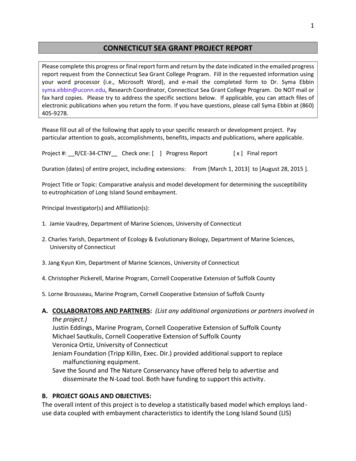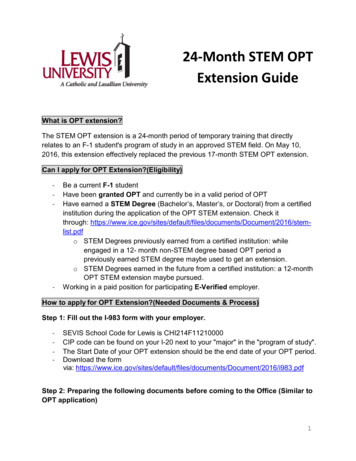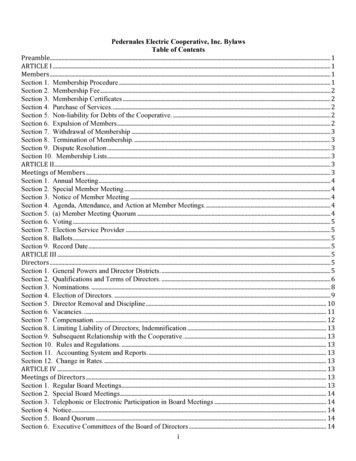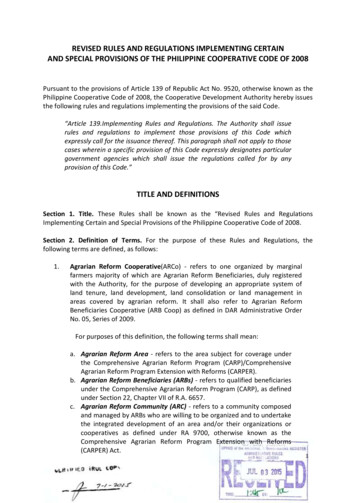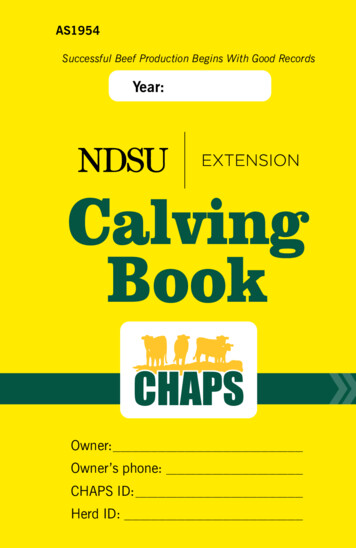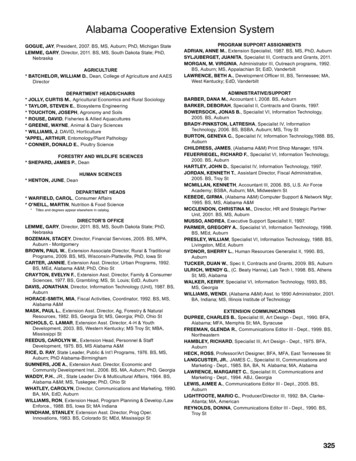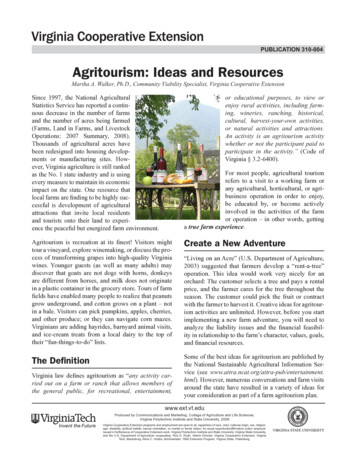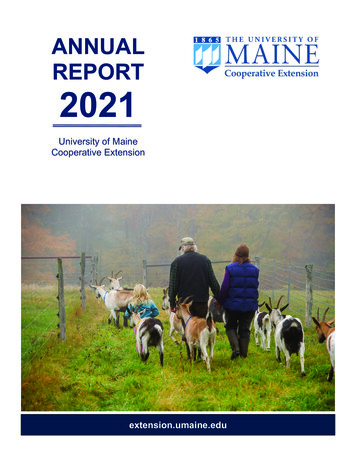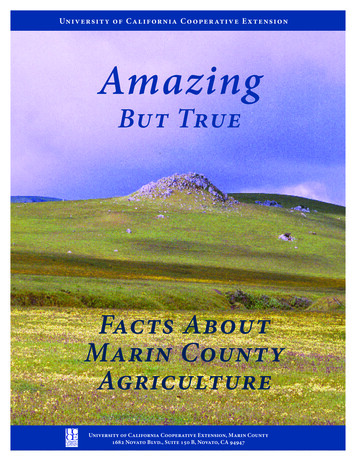
Transcription
Univ e r si t y of C a l i forn ia C o oper at iv e E xt en sionAmazingBut TrueFacts AboutMarin CountyAgricultureUniversity of California Cooperative Extension, Marin County1682 Novato Blvd., Suite 150 B, Novato, CA 94947
How Big is Ag ri cu lt ure ?What d o w e grow ?griculture is California’s number one industry, withsales of 44.7 billion in 2012 and over 400commodities. (Milk has the highest annual sales value).California provides a quarter of the nation’s food andnearly 50 percent of its fresh fruits and vegetables.Approximately 170,876 acres in Marin are farms orranches. This amounts to 50 percent of the land in Marin.Of the 323 agricultural operations in Marin, 110 areconsidered large farms (annual gross income of 100,000 ormore), and 213 are considered small or mini-farms (annualgross income of less than 100,000). The average size of afarm in Marin is 529 acres, and the majority are third- tofifth-generation family-owned operations.Marin’s topography is one of rolling hills, coastal bluffs andflat interior valleys separated by hills. While the hillytopography, prevalence of nonprime soils and lack ofreliable water supplies are deterrents to more intensiveagriculture like row crops, some areas in Marin that arerich in alluvial soils support diverse vegetable and specialtycrops.Marin’s coastal agriculture is well known for its qualitygrasslands, due to foggy, moist conditions that keep thegrasses green much of the year and make them well suitedfor grazing dairy, beef cattle and sheep.ALivestock production is the second largest agricultureindustry in the county, with 205 beef cattle, cow/calf, andsheep grazing operations producing livestock, replacementheifers for dairies and breeding stock. In many cases,local operators are producing grass fed and pasture raisedlivestock and selling products directly to clients.While milk and livestock products dominate Marin’sagricultural activities, a growing number of organicoperations (66) produce organic fruits, vegetables, andpasture on 42,000 acres.From 2007 to 2012 the number of poultry producersincreased from 25 to 47. 2014 poultry production in Marinwas valued at 11.9 million, over 10% of the total value.Agriculture in Marin contributes over 100 millionannually to the local economy, with milk productiondominating at 39 percent. More than 60% of this value isderived from organic milk.Summary of ProductionLivestock ProductsLivestock & Misc.Field CropsFruit, Grape & VegetableAquacultureNursery 3815,282,4755,532,431397,737 100,953,000 84,300,087The figures quoted above are the gross values and don’t includethe multiplying factor of 2.5 used to represent agriculture’scontribution to the local economy in associated areas, such astourism, employment opportunities, and support businesses inMarin communities.Of the over 7.5 million people who live in the greaterBay Area, only one to two percent have jobs in agriculture.Eighty percent of the jobs in agriculture occur off the farm.1
Fa r min g t he SeasOyster culture is the oldest aquaculture industry inCalifornia, dating back to the 1850s.Marin is second only to Humboldt Bay in Californiain shellfish production, which includes oysters, clams,and mussels. In 2014, six growers used bay bottom inTomales Bay and Drakes Estero to grow shellfish worthover 10.6 million. Many local restaurants want freshoysters and mussels for their customers, who often driveup from San Francisco for this fresh seafood.Marin has 70 miles of open coastline and 40 miles ofSan Francisco Bay frontage. Many types of fish live in thewaters of Marin, including salmon, rockfish,halibut, striped bass, sturgeon, ling cod, herring, andothers. Sport fishing and commercial boats leaveSausalito, Bolinas Lagoon and Tomales Bay to catch thesefish for food or sport. Today most of these species havedeclined in numbers, due to habitat loss, reduced freshwater flows into the bays, and over-fishing.The major fishery in San Francisco and Tomales Bayis for Pacific herring, which are processed for their roe(herring eggs). In 1918 a shortage of herring in the NorthSea caused increased demand and spurred productionlocally of about 4,000 tons. In the 1940s and ’50s,production increased further when the sardine fisherycollapsed and herring were used in their place forcanning. In the 1970s, herring were marketed to Japanfor their roe, and this market continues along with a newcrop of herring roe on kelp, wherein kelp is hung fromrafts and harvested after spawning fish deposit a layerof eggs on it. The peak sales for this fishery occurred in1995-1996 during the Japanese craze for herring roe.This roe-on-kelp fishery in San Francisco Bay produced106 tons in 1995-96, which at 20/lb. was valued at over 4.3 million. The herring gill net fishery and round haulfishery in San Francisco Bay produced 6,165 tons worth 18.5 million, while in Tomales Bay this fishery captured355 tons valued at just over 1 million. In 2006-2007,these declined to 292 tons and 182,780 value for SanFrancisco Bay and 1.2 tons and 744 for Tomales Bay.A major sport fishery for clams exists in Tomales Bay,where during low tides up to 100 enthusiasts spread outon mud flats to dig Washington clams and other bivalvesto barbecue and use in chowder.Several innovative operations have strong reputationsfor producing a high-quality product, such as Star RouteFarms vegetables and greens in Bolinas, Pt. ReyesOriginal Blue Cheese, Green Gulch Farms in Muir Beach,and Marin Sun Farms in Point Reyes. Check out thehttp://www.growninmarin.org site for more information onthese and other producers.Since 1983, the Marin Farmer’s Market (nowAgricultural Institute of Marin) has helped connectconsumers directly to farmers and their produce.There are approximately 80,000 “small farmers” inCalifornia, 5,000 of whom market to consumers directly atmore than 700 farmers’ markets all over the state.Several nurseries grow many crops, from roses and iristo heather and native plants.Several ranchers are experimenting with growing coolweather wine grapes and are hopeful of future marketpotential. A total of 14 commercial grape growersproduced 325 tons on 175 acres in 2014.There are approximately 36 dairies in Sonoma and 29dairies in Marin (including one sheep, one buffalo, and twogoat dairies) in Marin. 75% of Marin’s dairies are organic.Among the 43 counties in California that produce milk,Marin is ranked 15th.Marin’s sister county, Sonoma, has four times thenumber of farms and ten times the annual output inincome (over 848 million in 2014). Marin and Sonomafarmers share many things in common, from familyrelationships to agricultural suppliers.2
Who A re We ?Where H av e We C ome From ?Today’s farmer and rancher is anexpert in many areas, includinggenetics, nutrition, business,marketing, and mechanicalrepair. Many farmers andranchers have college degrees.Families in the North Bayhave been dairying for over 100years. Marin and the region’s firstdairy ranchers were mostly Swiss,Italian, Portuguese and Irish.Dairying and farming is very demanding work, sevendays a week, 12 or more hours per day.Dairies and their families have strong ties to their localcommunities. Bankers, accountants, feed suppliers,veterinarians, milktesters, equipmentretailers, feed millsand milk haulers allwork in agriculture inMarin. Manufacturing,marketing, anddistribution of milkproducts employ awhole other segment ofthe community.In Marin, more than half our farms and ranches reporthiring farm labor, with 576 workers employed by producerswith both part-time and full-time employees. There are 14farms in Marinthat report usingmigrant farmlabor. More than 7.4 million isspent on on-farmemployee payroll(Census of 2012).Of the 82farms that haveemployees, 32%have five or more employees, while 68% report employingfour or fewer workers.3In the early 1820s, Marin was settled by the Mexicans,whose home base was the San Rafael mission. TheMexicans raised thousands of longhorn cattle for theirhides and tallow. The cattle ran wild along with herds ofnative tule elk and were rounded up yearly by Mexican andMiwok vaqueros.After the mission was shut down in 1834, the land andthe longhorns were divided up into vast ranchos. Duringthe Gold Rush of 1849, the longhorns were driven to thegold country. After the Gold Rush faded, ranchers began tointroduce American stock to replace the Mexican cattle andthe tule elk, wiped out by hunting and loss of habitat.The Gold Rushof 1849 helped startthe dairy industry.In the 1850s a SanFrancisco law firmowned most ofthe Point Reyespeninsula andestablished severalvery successfultenant ranches. These kinds of dairy ranches, owned byabsentee landowners, were also set up in Sausalito. Theynot only produced dairy products, but huge crops of fruit.At that time, most dairy operations were small, 10 to 15cows, or as many as they could milk by hand. Cows weremilked twice a day.Before refrigeration, all the milk produced was churnedinto butter. In 1862 Marin provided a quarter of California’sbutter. Fresh milk was poured into pans and cooled. Thecream was skimmed from the top, churned into butter andsalted to preserve it. Some families made their own cheeseor used the skills of a cheesemaker who traveled fromranch to ranch.Since land travel was limited to horse trails and wagonroads, creeks and waterways were the major links to theSan Francisco market.The Marin coastal towns of Bolinas and Tomales wereshipping ports for agricultural products. Tons of potatoes,grains, clams and dairy products like cheese and butter wereshipped from warehouses to eager markets in San Francisco.Flat-bottomed hay schooners were important boats formoving hay to hungry San Francisco horses and livestock.They also carried wheat and barley, vegetables, salt, dairyproducts, lumber and bricks from Marin brickyards. Onecan visit the Alma, a restored schooner now at the NationalHistorical Park in San Francisco. Ross Landing in Kentfieldwas one of Marin’s busiest ports until the trains came in the1880s.Towns like Tomales, Olema and Nicasio were earlytrading centers for Marin’s growing dairy ranches.Potatoes were a huge crop in the Tomales area from the
P reserv in g Agric ult ureBetween 1949 and 1982 about 783,000 acres, orroughly one-quarter of the Bay Area’s farmland, waslost to development. Since 1959 Marin has lost 32,0001850s to 1900. The steep hillsides planted in vertical rowcrops couldn’t take the intensive cultivation, and theresulting erosion caused tremendous sedimentation ofTomales Bay, the Esteros and Key’s Creek.In 1870 the North Pacific coast railroad was completed,acres of agricultural lands. (1944 census figures show 1,800ranches, as compared to 276 today.)traversing Marin and connecting coastal towns to SanFrancisco. All kinds of agricultural products traveled southon the railroad. Towns along the railroad (Fairfax, MillValley, San Rafael) blossomed, while those bypassed by thetrains froze in time.Since the 1800s, when dairying developed in Marin,the dairy industry has been known for its high-qualitydelicious milk. The invention of the milk bottle in 1884made handling and distribution of milk much easier. TheCalifornia Cooperative Creamery was established in 1913by local milk producers to process and distribute the milkproducts (milk, butter, cheese). Today most Marin milkis transported in trucks to several creameries in Petalumaand elsewhere. Increasingly, portions of this milk is beingused on farm or shipped to local cheese makers. Currentlythere are 35 farmstead and artisan cheese makers, makingMarin the Normandy west of the Mississippi.By the 1920s U.C. Berkeley, a land-grant university,was sending agricultural agents out to ranchers to spreadnew information and methods. M.B. Boissevain was thefirst farm advisor in Marin County. He was followedby successive advisors introducing innovations in dairyproduction, livestock grazing, and diversification thatsupport porduction today.By 1930 most ranches on the Point Reyes Peninsulawere independently owned. Six dairy ranchers and 15grazing ranches continue their operations as part of theIn the early 1970s, Marin’s agriculture was threatenedwhen plans for major highway extensions to the coast weredeveloped. The county was rezoned to include three majorplanning corridors, of which two – the coastal recreationand inland rural corridors – contain most of the agriculturein Marin today. They are protected by A-60 zoning, whichallows no more that one house per 60 acres.In 1950 there were 200 dairy ranches in Marin. Therewere 150 in 1960 and fewer than 100 in 1972. A groupof ranchers and local environmentalists came togetherto create the Marin Agricultural Land Trust as a way ofpreserving agricultural lands. Since MALT’s beginning in1980, it has acquired agricultural conservation easementson nearly 48,000 acres on 76 family farms, protecting andkeeping those lands forever in agriculture.-- David Lewis, U.C. Cooperative Extension, July 2014(For more information and statistics, go to t Reyes National Seashore, a national park.4
University of CaliforniaCooperative Extension - Marin County1682 Novato Blvd., Suite 150BNovato, California 94947(415)473-4204; (415)473-4209 (fax)http://cemarin.ucdavis.edu; http://www.growninmarin.orgProduction Credits:Published by the University of CaliforniaCooperative Extension, Marin CountyDavid Lewis, Paige Phinney & Ellie RIlla, EditorsFrances Healey, Layout and DesignSteve Quirt, PhotosUniversity of California and United States Department of Agriculture & County of Marin Cooperating
rafts and harvested after spawning fish deposit a layer of eggs on it. The peak sales for this fishery occurred in 1995-1996 during the Japanese craze for herring roe. This roe-on-kelp fishery in San Francisco Bay produced 106 tons in 1995-96, which at 20/lb. was valued at over 4.3 million. The herring gill net fishery and round haul

